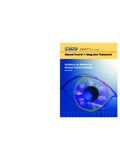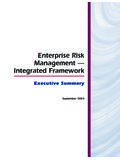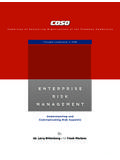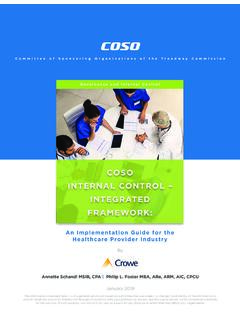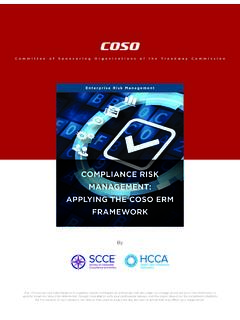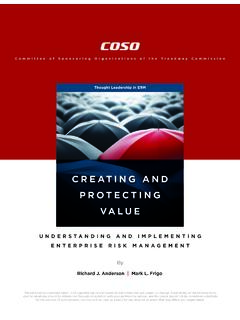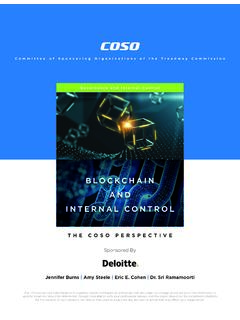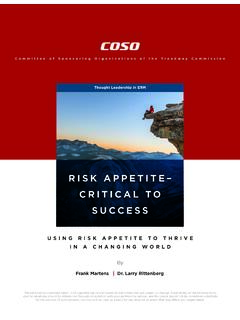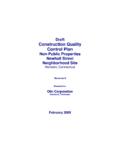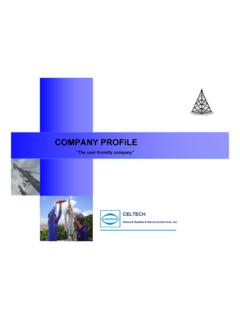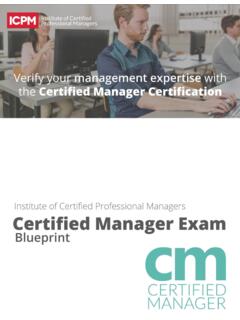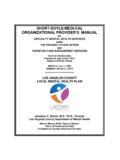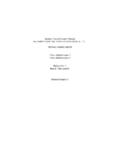Transcription of ImPrOvInG OrGanIzaTIOnal PerFOrmanCe and …
1 Committee of Sponsoring Organizations of the Treadway CommissionGovernance and Operational PerformanceByHow the COSO Frameworks Can HelpThe information contained herein is of a general nature and based on authorities that are subject to change. Applicability of the information to specific situations should be determined through consultation with your professional adviser, and this paper should not be considered substitute for the services of such advisors, nor should it be used as a basis for any decision or action that may affect your OrGanIzaTIOnalPerFOrmanCe and governance James deloachJeff Thomson Cma, CaeauthorsProtiviti James deloachManaging DirectorIma (Institute of management accountants)Jeff Thomson, Cma, CaePresident and CEOThis project was commissioned by the Committee of Sponsoring Organizations of the Treadway Commission (COSO)
2 , which is dedicated to providing thought leadership through the development of comprehensive frameworks and guidance on enterprise risk management, internal control, and fraud deterrence designed to improve OrGanIzaTIOnal PerFOrmanCe and governance and to reduce the extent of fraud in is a private-sector initiative jointly sponsored and funded by the following organizations: american accounting association (AAA) american Institute of CPas (AICPA) Financial executives International (FEI) The Institute of management accountants (IMA) The Institute of Internal auditors (IIA)acknowledgementsThe authors wish to thank David Landsittel, Larry Rittenberg, James Pajakowski and Jay Thompson for their valued input and ideas in framing this paper and Michael McGarry and Darci Lowe for their assistance with the necessary addition, they wish to thank the COSO Board for its support of this of Sponsoring Organizationsof the Treadway Board membersrobert B.
3 Hirth, Chairdouglas F. PrawittAmerican Accounting Associationrichard F. ChambersThe Institute of Internal Auditorsmarie n. HolleinFinancial Executives InternationalCharles e. landesAmerican Institute of CPAs (AICPA)Sandra richtermeyerInstitute of Management AccountantsGovernance and Operational PerformanceImPrOvInG OrGanIzaTIOnalPerFOrmanCe and governance Committee of Sponsoring Organizations of the Treadway CommissionFebruary 2014 research Commissioned byresearch Commissioned byHow the COSO Frameworks Can HelpCopyright 2014, The Committee of Sponsoring Organizations of the Treadway Commission (COSO).1234567890 PIP 198765432 All Rights Reserved. No part of this publication may be reproduced, redistributed, transmitted or displayed in any form or by any means without written permission. For information regarding licensing and reprint permissions please contact the American Institute of Certified Public Accountants licensing and permissions agent for COSO copyrighted all inquiries to or AICPA, Attn: Manager, Rights and Permissions, 220 Leigh Farm Rd.
4 , Durham, NC 27707. Telephone inquiries may be directed to and Operational PerFOrmanCe | ImPrOvInG OrGanIzaTIOnal PerFOrmanCe and governance | iiiIntroduction 1executive Summary 2a Contextual Business model 3 Why the Frameworks are Important to governance 6 Why the Frameworks are Importantto Strategy Setting and Business Planning 9 Why the Frameworks are Important to execution 12 Why the Frameworks are Important to monitoring 13 Why the Frameworks are Important to adapting 14 Key Takeaways and Observations 16 Closing remarks 18appendix What the Frameworks Say 19 enterprise risk management Integrated Framework 19 Internal Control Integrated Framework 19about COSO 24about the authors 24 Contents and Operational PerFOrmanCe | ImPrOvInG OrGanIzaTIOnal PerFOrmanCe and governance | mission of
5 The Committee of Sponsoring Organizations (COSO) reads, in part, to improve OrGanIzaTIOnal PerFOrmanCe and governance . Since their inception, COSO s Enterprise Risk Management Integrated Framework1 and Internal Control Integrated Framework2 (collectively referred to as the COSO frameworks ) were both intended to provide guidance for management on how to implement and evaluate effective enterprise risk management (ERM) and internal control processes, leading to the improvement of management and governance processes. When applied effectively, the frameworks concepts contribute to the end result of ImPrOvInG OrGanIzaTIOnal PerFOrmanCe and governance in significant ways. Our purpose in writing this paper is to relate the COSO frameworks to an overall business model and describe how the key elements of each framework contribute to an organization s long-term success.
6 COSO s fundamental premise is that good risk management and internal control are necessary for long term success of all organizations and we seek to support that premise by articulating how the frameworks contribute to ImPrOvInG OrGanIzaTIOnal PerFOrmanCe and governance . We do not seek to compare the two frameworks directly, as each framework includes a comparative analysis in an As we proceed, we intend to draw from the COSO frameworks, as appropriate, with a presumption that the reader has an understanding of the frameworks. In addition, this paper applies to any organization choosing to use either or both of the COSO frameworks. Introduction1 Enterprise Risk Management Integrated Framework, Committee of Sponsoring Organizations, September 2004. Available at 2 Internal Control Integrated Framework, Committee of Sponsoring Organizations, May 2013.
7 Available at See Appendix C of Enterprise Risk Management Integrated Framework and Appendix G of Internal Control Integrated Framework. 2 | ImPrOvInG OrGanIzaTIOnal PerFOrmanCe and governance | governance and Operational paper describes the COSO frameworks in the context of a fairly standard leadership umbrella for governing and managing a successful organization. The frameworks are intended to be integrated within the governance and management processes to establish accountability for ERM and internal control. Either framework can be applied with positive results, , companies can implement the internal control framework without implementing the ERM framework. The governance concepts included in both frameworks,4 are vital to their effective application by organizations. Within the context of its mission, an organization is designed to accomplish objectives.
8 It is presumed that the organization s leaders can articulate its objectives, develop strategies to achieve those objectives, identify the risks to achieving those objectives and then mitigate those risks in delivering the strategy. The ERM framework is based on objective setting and the identification and mitigation or acceptance of risks to the achievement of objectives. The internal control framework is designed to control risks to the achievement of objectives by reducing them to acceptable levels. Thus, each of the frameworks is inextricably tied into the operation of a business through the achievement of objectives. ERM is applied in the strategy-setting process while internal control is applied to address many of the risks identified in strategy setting. The ERM framework asserts that well-designed and effectively operating enterprise risk management can provide reasonable assurance to management and the board of directors regarding achievement of an entity s objectives.
9 Likewise, the internal control framework asserts that internal control provides reasonable assurance to entities that they can achieve important objectives and sustain and improve reasonable assurance concept embodied in both frameworks reflects two notions. First, uncertainty and risk relate to the future, which cannot be precisely predicted. Second, risks to the achievement of objectives have been reduced to an acceptable general, ERM involves those elements of the governance and management process that enable management to make informed risk-based decisions. Informed risk responses, including the internal controls that accompany them, are designed to reduce the risk associated with achieving OrGanIzaTIOnal objectives to be within the organization s risk Therefore, ERM/internal control and the objective of achieving the organization s strategic goals are mutually Summary4 Specifically, governance concepts are included in the internal environment component in Enterprise Risk Management Integrated Framework and control environment component in Internal Control Integrated Framework.
10 5 For more information on the development of risk appetite, see the COSO thought paper Enterprise Risk Management Understanding and Communicating Risk Appetite, Dr. Larry Rittenberg and Frank Martens, January 2012. Available at governance and Operational PerFOrmanCe | ImPrOvInG OrGanIzaTIOnal PerFOrmanCe and governance | Contextual Business modelWe have chosen a simple but holistic view of governance and management processes (see Figure 1) to illustrate the integration of the COSO frameworks into the core activities of a business. This general business model encompasses most management model begins with governance , which starts with the organization s vision and mission and consists of oversight from the board of directors of the enterprise s planning and operations. Also included are the activities of executive management in ensuring the effectiveness of strategy setting and the organization s other management processes.
